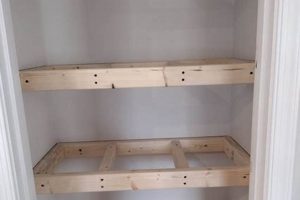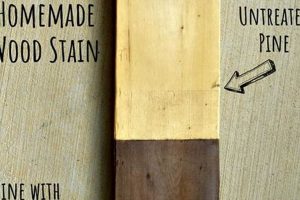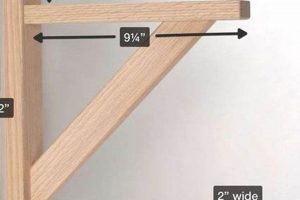A homemade lighting fixture constructed primarily from timber represents an avenue for personalized illumination. Such projects involve the selection of wood, design, fabrication, and assembly of electrical components. A simple example involves using a salvaged branch as the base for a bedside light, while more complex projects can incorporate intricate joinery and embedded electronics.
Creating these custom fixtures offers cost savings compared to purchasing commercially manufactured products. Furthermore, it provides an opportunity for creative expression and customization, allowing individuals to tailor lighting to specific aesthetic preferences and functional needs. Historically, crafting lighting solutions from available materials was a necessity; contemporary iteration reflects a blend of resourcefulness and artistic intent.
The subsequent sections detail material selection, construction techniques, wiring safety, and design considerations essential for successful construction. Examination of these elements is crucial for realizing a safe and aesthetically pleasing outcome.
Construction Guidance
The following guidelines are intended to assist in the safe and effective creation of a timber-based lighting device. Adherence to these principles enhances both the functionality and aesthetic quality of the finished product.
Tip 1: Material Selection: Prioritize hardwoods such as oak, maple, or walnut for structural integrity and visual appeal. Softwoods, while easier to work with, may require additional treatment for durability. Consider reclaimed lumber for an environmentally conscious approach, but ensure its structural soundness.
Tip 2: Design Considerations: Draft a detailed plan before commencing construction. Account for the lamp’s overall dimensions, stability, and the placement of electrical components. A scale model or 3D rendering aids in visualizing the final product and identifying potential design flaws.
Tip 3: Electrical Safety: Employ Underwriters Laboratories (UL) listed electrical components, including wiring, sockets, and plugs. Adhere to local electrical codes and regulations during wiring procedures. Use a multimeter to verify continuity and proper grounding before connecting the lamp to a power source.
Tip 4: Joinery Techniques: Utilize robust joinery methods such as mortise and tenon, dovetail, or dowel joints to ensure structural stability. Consider the aesthetic impact of the chosen joinery technique on the lamp’s overall design. Precisely cut and assemble components to minimize gaps and ensure a seamless finish.
Tip 5: Finishing Applications: Apply a sealant or finish to protect the wood from moisture and enhance its natural grain. Consider the desired aesthetic: oil-based finishes provide a warm, natural look, while polyurethane offers greater durability. Follow manufacturer’s instructions regarding application techniques and drying times.
Tip 6: Cord Management: Plan for discreet cord management within the structure. This may involve routing the cord through channels or securing it with clips. Ensure that the cord exits the lamp base in a manner that minimizes strain and prevents tripping hazards.
These guidelines emphasize the importance of careful planning, precision, and adherence to safety protocols in creating a custom lighting fixture. Implementing these techniques will yield a functional and visually appealing result.
The subsequent discussion explores specific design styles and project ideas, providing further inspiration for individual creative endeavors.
1. Material Selection
Material selection forms a foundational element in the successful construction of a timber-based lighting apparatus. The choice of wood significantly influences structural integrity, aesthetic appeal, and the overall lifespan of the finished product.
- Hardwood vs. Softwood Properties
Hardwoods, derived from deciduous trees, typically offer superior density and resistance to wear. Species such as oak, maple, and walnut exhibit excellent dimensional stability and are well-suited for structural components. Softwoods, originating from coniferous trees, are generally more pliable and easier to work with, but may require protective coatings or reinforcement to ensure long-term durability. Pine and cedar are examples commonly found in less demanding applications.
- Reclaimed Lumber Considerations
Utilizing reclaimed lumber presents an environmentally conscious alternative, reducing demand for newly harvested timber. However, reclaimed materials may exhibit varying degrees of degradation, requiring careful inspection for structural soundness. Previous exposure to moisture, pests, or chemical treatments necessitates thorough assessment and potentially remediation before incorporation into a lighting fixture.
- Aesthetic and Finish Compatibility
The natural grain, color, and texture of the selected wood profoundly affect the aesthetic character of the lamp. Different wood species exhibit varying responses to staining, painting, and sealing treatments. Compatibility between the chosen finish and the wood type is crucial for achieving a desired visual outcome and ensuring long-term protection against environmental factors.
- Sustainability and Ethical Sourcing
The sourcing of timber carries ethical and environmental implications. Opting for sustainably harvested wood certified by organizations such as the Forest Stewardship Council (FSC) promotes responsible forestry practices. Furthermore, locally sourced timber minimizes transportation costs and supports regional economies, contributing to a more sustainable supply chain.
These material considerations collectively determine the structural integrity, aesthetic value, and environmental impact of the constructed lighting fixture. Careful evaluation of wood properties, sourcing practices, and finishing compatibility is essential for realizing a durable, visually appealing, and responsibly produced lighting solution.
2. Structural Integrity
Structural integrity, in the context of constructing a lighting fixture from timber, denotes the capacity of the assembly to withstand applied loads and environmental stresses without deformation or failure. This attribute is paramount for safety and longevity. A compromised design, utilizing inadequate joinery or insufficient material thickness, can lead to instability, posing risks of collapse and electrical hazards. For example, a top-heavy design with a slender base might easily topple, potentially damaging the lamp, surrounding objects, or causing injury. Conversely, a robust frame constructed with mortise-and-tenon joints using seasoned hardwood provides a stable and enduring foundation. This connection is vital; the quality of the construction directly correlates to the lamp’s service life and safety profile.
Further illustrating the practical significance, consider the effects of environmental factors. Changes in humidity can induce wood to expand or contract, potentially weakening joints and compromising the overall stability. A well-engineered design anticipates these fluctuations, incorporating appropriate tolerances and employing moisture-resistant finishes. Similarly, the weight of the lamp shade and electrical components must be factored into the structural calculations. Overloading a poorly constructed frame can lead to gradual deformation or sudden failure. Therefore, proper joint selection, material selection with appropriate thickness and design considerations are integral to creating a safe and durable light fixture.
In summation, structural integrity is not merely a desirable feature but a fundamental prerequisite for a successful timber-based lighting project. Its absence invites instability and potential danger. Attention to design principles, material properties, and construction techniques is essential to ensure a durable and safe final product, embodying the principles of sound engineering practice. Ignoring it poses safety hazard.
3. Electrical Safety
The integration of electrical components within a timber-based lighting fixture necessitates strict adherence to safety protocols to mitigate potential hazards. Electrical safety is not merely a precautionary measure but a fundamental requirement for ensuring the well-being of users and preventing property damage. Improper wiring, inadequate insulation, or the use of non-compliant components can lead to electric shock, fire, or equipment malfunction.
- Component Selection and Certification
Employing electrical components that bear the mark of recognized testing laboratories, such as Underwriters Laboratories (UL) or Intertek (ETL), provides assurance of compliance with established safety standards. These certifications indicate that the components have undergone rigorous testing to verify their performance and safety characteristics. Examples include using UL-listed sockets, switches, and wiring of appropriate gauge for the intended voltage and current.
- Wiring Techniques and Insulation
Proper wiring techniques are critical to prevent short circuits and electrical leakage. Wires must be securely connected using appropriate connectors or soldering, and all connections must be adequately insulated using electrical tape or heat-shrink tubing. The insulation rating of the wiring must be sufficient for the operating voltage to prevent breakdown and potential shock hazards. Grounding is crucial in metallic light fixtures.
- Grounding and Fault Protection
Grounding the metallic parts of a lighting fixture provides a path for fault current to flow back to the source, tripping a circuit breaker or ground fault circuit interrupter (GFCI). This protective measure minimizes the risk of electric shock in the event of a fault. A GFCI outlet, commonly found in bathrooms and kitchens, can detect even small imbalances in current flow and quickly interrupt the circuit, providing an additional layer of safety.
- Cord Management and Strain Relief
Proper cord management is essential to prevent damage to the power cord, which can expose live wires and create a shock hazard. Strain relief devices, such as cord grips or knots, should be used to secure the cord where it enters the lamp base, preventing it from being pulled out or damaged. The cord must be of appropriate length and gauge for the intended application, and it should be inspected regularly for signs of wear or damage.
These facets of electrical safety are interconnected and equally important in the construction of a DIY wood lamp. Neglecting any one of these aspects can compromise the overall safety of the fixture. By adhering to established standards and best practices, it is possible to create a custom lighting solution that is both aesthetically pleasing and electrically safe.
4. Design Aesthetics
Design aesthetics plays a pivotal role in shaping the character of a timber-based lighting fixture. Beyond mere functionality, the aesthetic considerations influence its integration within a given environment and reflect the creator’s artistic vision. The interplay between form, material, and light determines the overall visual impact.
- Form and Silhouette
The lamp’s overall shape dictates its visual presence. A minimalist, geometric design projects a modern sensibility, while organic, curving forms evoke a natural aesthetic. The silhouette interacts with the surrounding space, creating visual interest through positive and negative space. Consider, for instance, a sleek, cylindrical lamp with a sharp, clean outline versus a lamp fashioned from a gnarled branch, each conveying distinct styles.
- Material Texture and Color
The inherent qualities of the chosen wood contribute significantly to the aesthetic. Smooth, polished surfaces convey elegance and sophistication, while rough, textured finishes suggest rustic charm. The natural color of the wood, whether light and airy or dark and rich, influences the mood of the space. For instance, a lamp crafted from light-colored maple imparts a sense of airiness, while a lamp made from dark walnut exudes warmth and depth.
- Light and Shadow Play
The design should consider how light interacts with the wood. Cutouts, perforations, or textured surfaces create patterns of light and shadow, adding visual complexity. The type of lampshade chosen influences the diffusion and direction of light, impacting the ambiance of the room. An example includes a lamp with geometric cutouts casting intricate shadows on the surrounding walls, versus a lamp with a simple, opaque shade providing focused illumination.
- Scale and Proportion
The size of the lamp relative to its environment and the proportions of its various components contribute to its overall aesthetic harmony. A lamp that is too large can overwhelm a small space, while a lamp that is too small can appear insignificant. The relative sizes of the base, stem, and shade should be carefully considered to achieve a balanced and pleasing composition. A towering floor lamp demands a large space, while a petite table lamp fits discreetly on a bedside table.
These facets collectively define the design aesthetic of a timber-based lighting fixture. Careful consideration of form, material, light, and scale is essential for creating a lamp that not only provides illumination but also serves as a statement piece, enriching the aesthetic quality of its surroundings. The successful DIY execution harmonizes these elements into a cohesive and visually compelling result.
5. Finishing Technique
The finishing technique employed on a timber-based lighting fixture profoundly impacts its aesthetic appeal, durability, and longevity. This process represents the final stage of fabrication, during which a protective coating is applied to the wood surface. The selection and application of this finish are critical because they directly influence the fixture’s resistance to environmental factors, such as moisture and ultraviolet radiation, and contribute significantly to its overall visual character. For instance, a clear polyurethane finish on a walnut lamp base enhances the wood grain while providing a durable barrier against scratches and spills. Conversely, an improperly applied finish can result in an uneven surface, detracting from the lamp’s appearance and potentially compromising its structural integrity over time.
Different finishing techniques cater to various aesthetic preferences and functional requirements. Oil-based finishes, such as tung oil or linseed oil, penetrate the wood fibers, creating a warm, natural appearance and highlighting the grain. These finishes offer limited protection against moisture but are relatively easy to repair. Water-based finishes, on the other hand, provide a more durable and environmentally friendly option, offering excellent resistance to scratches and UV damage. Milk paint, another alternative, imparts a vintage or rustic aesthetic. The choice of finish must align with the intended use of the lamp and the desired aesthetic outcome. For a lamp designed for outdoor use, a marine-grade varnish is essential to withstand exposure to the elements. For indoor applications, considerations of VOC content and ease of maintenance should also be factored in. The appropriate preparation, including sanding and priming, is also critical to achieve a uniform and durable result.
In summary, the finishing technique is an integral component of timber-based lighting fixture construction, directly influencing its visual appeal, durability, and protection against environmental factors. Understanding the properties of different finishes and their compatibility with various wood species is essential for achieving a high-quality and long-lasting result. While the selection process can be complex, careful consideration of aesthetic preferences, functional requirements, and environmental concerns will ensure that the chosen finish enhances the beauty and longevity of the fixture. A well-executed finish not only protects the wood but also elevates the lamp from a functional object to a work of art.
6. Light Diffusion
Light diffusion, the process of scattering light to reduce glare and create a softer, more even illumination, is a critical design consideration for timber-based lighting fixtures. The manner in which light is dispersed significantly impacts the ambiance and functionality of the resulting lamp.
- Shade Material and Opacity
The material comprising the lamp shade dictates the extent to which light is scattered or transmitted directly. Opaque materials, such as thick fabrics or dense paper, block the majority of light, directing it primarily downward. Translucent materials, like frosted glass or thinner fabrics, allow a portion of light to pass through while simultaneously diffusing it, creating a softer glow. For example, a lamp utilizing a burlap shade provides a textured diffusion, creating a warm and rustic aesthetic, whereas a frosted glass shade offers a more uniform and diffused light, suitable for task lighting.
- Surface Texture and Patterning
The surface texture of the wood and any incorporated patterns influence light diffusion. Roughened surfaces or those featuring intricate carvings scatter light in multiple directions, reducing glare and creating a more visually interesting illumination pattern. Conversely, smooth, polished surfaces reflect light more directly, potentially causing glare. A lamp with a carved wooden shade will project intricate patterns of light and shadow, adding visual depth to the space, in contrast to a lamp with a smooth, unadorned wooden base, which may offer minimal light diffusion.
- Lamp Placement and Orientation
The positioning of the lamp and the orientation of the light source relative to the shade affect the distribution of light within a room. Placing a lamp in a corner allows the light to reflect off multiple surfaces, increasing the overall level of diffused illumination. Orienting the bulb such that the light is directed upwards can create a softer, more ambient glow. A floor lamp positioned behind a sofa and directed towards the ceiling provides indirect, diffused lighting, whereas a desk lamp with a focused beam offers more direct and less diffused illumination.
- Use of Diffusers and Filters
Incorporating additional diffusing elements, such as internal diffusers or colored filters, allows for further control over the quality of light. Diffusers, typically made of frosted glass or plastic, soften the light and reduce harsh shadows. Filters can alter the color temperature of the light, creating a warmer or cooler ambiance. For example, a lamp with an internal diffuser made of opal glass will produce a soft, even light, while a lamp with a blue-tinted filter will cast a cool, calming glow.
The interplay between shade material, surface texture, lamp placement, and the use of diffusers determines the ultimate character of light emanating from the fixture. The effectiveness of light diffusion directly influences the user experience, and successful implementation is critical to achieving the desired illumination effect. Understanding this connection is key to creating a wood-based lighting fixture that meets both aesthetic and functional requirements.
Frequently Asked Questions
The following questions and answers address common concerns and misconceptions related to the design, construction, and safety of lighting fixtures constructed from timber. This section aims to provide clarity and guidance for individuals undertaking such projects.
Question 1: Is specialized woodworking experience required to construct a timber lighting fixture?
While advanced joinery techniques can enhance the structural integrity and aesthetic appeal, basic woodworking skills, coupled with careful planning and execution, are often sufficient. Simpler designs utilizing readily available hardware and pre-cut lumber can be effectively executed by individuals with limited experience.
Question 2: What wood species are unsuitable for lighting fixture construction?
Species exhibiting high resin content, such as certain types of pine, may pose a fire hazard due to potential ignition from heat generated by the light source. Similarly, woods prone to warping or cracking may compromise structural stability. Selection of seasoned, stable hardwoods is generally recommended.
Question 3: What electrical safety precautions are paramount when wiring a timber lighting fixture?
The use of Underwriters Laboratories (UL) listed components, adherence to local electrical codes, and proper grounding techniques are non-negotiable. Wiring must be appropriately insulated and protected from abrasion or compression. Circuit breakers or ground fault circuit interrupters (GFCIs) provide crucial overcurrent protection.
Question 4: How can the risk of fire be minimized in a timber lighting fixture?
Employing low-wattage LED bulbs, which generate significantly less heat than incandescent alternatives, is essential. Maintaining adequate clearance between the bulb and any flammable materials is crucial. Regularly inspecting the fixture for signs of overheating or damage is also recommended.
Question 5: What types of finishes are most appropriate for a timber lighting fixture?
Finishes should be selected based on their aesthetic qualities, durability, and resistance to moisture and ultraviolet radiation. Water-based finishes, oil-based finishes, and varnishes are common choices, each offering distinct advantages and disadvantages. Proper surface preparation is crucial for optimal adhesion and performance.
Question 6: How does light diffusion affect the overall ambiance created by a timber lighting fixture?
The degree of light diffusion directly influences the brightness, glare, and overall mood of the space. Opaque shades direct light downward for focused illumination, while translucent shades diffuse light more broadly, creating a softer ambiance. Surface textures and patterns can also contribute to light diffusion.
These frequently asked questions highlight the importance of careful planning, material selection, and adherence to safety protocols when constructing timber-based lighting fixtures. A thorough understanding of these principles is essential for achieving a safe, functional, and aesthetically pleasing outcome.
The following section explores common design styles and project ideas for inspiration in crafting personalized lighting solutions.
Conclusion
The preceding exploration of timber-based lighting construction reveals a multifaceted endeavor, demanding consideration of structural integrity, electrical safety, aesthetic design, and the principles of light diffusion. The discussion underscores the importance of careful planning, informed material selection, and adherence to established safety standards for successful execution.
The creation of customized lighting solutions from timber offers an avenue for individual expression and functional enhancement of living spaces. Continued investigation into innovative designs, sustainable materials, and refined construction techniques promises to further elevate the art and science of homemade illumination. Responsible craftsmanship and a commitment to safety remain paramount considerations for future endeavors in this domain.







